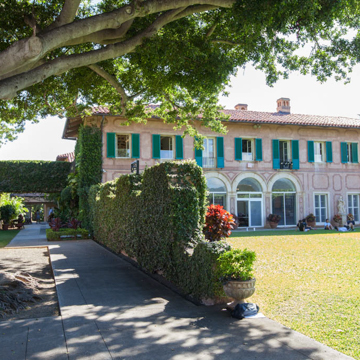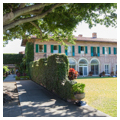You are here
Hawaii School for Girls
Named after the Renaissance villa in which the Dillinghams were wed, La Pietra's design draws on a number of other Florentine villas for its inspiration, including the Villa Gamberaia for the northwest facade. One of the most magnificent houses in Hawaii for its time, and the social center for the city, La Pietra hosted such guests as President Franklin D. Roosevelt, Thailand's King Prajadhipok, Edward Albert the Prince of Wales, Bing Crosby, Walt Disney, and a host of others. The two-story, pink, plastered, bluestone house is built around a central patio lined with arcades. The plan, coupled with an extensive use of French doors and wrought-iron balconies, mitigates the formality of the interior, and allows for open, well-ventilated rooms. The patio is paved with Kahuku sandstone while its arcade's sandstone Doric columns were quarried off the coast of Kalailoa. This material, as well as cast stone, also appears in the door frames and windowsills. The second-story's ohia flooring came from the Irwin house (1899), which was demolished to make way for the War Memorial Natatorium (OA151). The original dining room's terrazzo floors and coffered ceiling are also worthy of notice.
The house was given to Punahou School in 1964, following Mr. Dillingham's death. In 1968, John Tatom oversaw the residence's conversion to the Hawaii School for Girls. At this time, the tiled, pent roof covering the patio's arcade was removed and the second-floor exterior corridors were added in order to meet fire code. The original mansion's ten-acre grounds were reduced with an expansion of the school and development of condominiums.
Writing Credits
If SAH Archipedia has been useful to you, please consider supporting it.
SAH Archipedia tells the story of the United States through its buildings, landscapes, and cities. This freely available resource empowers the public with authoritative knowledge that deepens their understanding and appreciation of the built environment. But the Society of Architectural Historians, which created SAH Archipedia with University of Virginia Press, needs your support to maintain the high-caliber research, writing, photography, cartography, editing, design, and programming that make SAH Archipedia a trusted online resource available to all who value the history of place, heritage tourism, and learning.













